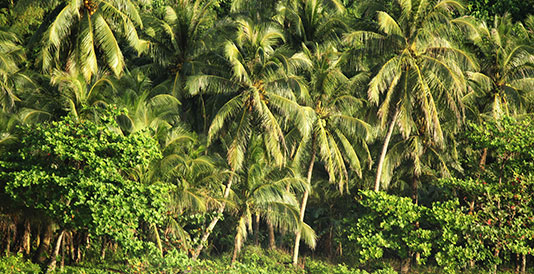 May 29, 2018 (Source: Jack Putz) - A recently published paper in Global Change Biology discusses how tropical forests provide critical ecosystem services for life on Earth including climate protection by storing large amounts of carbon. One big challenge is that these forests are located in poor countries where improvement of human livelihoods is paramount. The study, led by researchers from Boise State University, sheds light on how to balance timber production and carbon storage in tropical forests. The researchers used field data and mathematical models to determine thresholds for logging intensity, after which tropical forests managed for timber begin to lose their ability to recover their carbon stocks and supply timber. The focus on timber stand management is warranted by the fact that half of all remaining tropical forests are being logged.
May 29, 2018 (Source: Jack Putz) - A recently published paper in Global Change Biology discusses how tropical forests provide critical ecosystem services for life on Earth including climate protection by storing large amounts of carbon. One big challenge is that these forests are located in poor countries where improvement of human livelihoods is paramount. The study, led by researchers from Boise State University, sheds light on how to balance timber production and carbon storage in tropical forests. The researchers used field data and mathematical models to determine thresholds for logging intensity, after which tropical forests managed for timber begin to lose their ability to recover their carbon stocks and supply timber. The focus on timber stand management is warranted by the fact that half of all remaining tropical forests are being logged.
The study was based on over two decades of data from Guyana, a biodiverse country that is globally important as a forest carbon reservoir. The results provide novel insights into logging practices compatible with maintenance of the carbon and timber values of these forests. The researchers found that recovery rates of forests after logging, even with the application of the highest standards of logging practices known as reduced-impact logging (RIL), depends on the presence of old growth. Overall, the benefits of RIL diminish at high logging intensities. An additional experimental treatment, the liberation from competition of small commercial trees, successfully increased timber yields but the forest stored 20% less carbon.
Professor Jack Putz from the University of Florida, the senior collaborator on the study, pointed out major challenges for tropical forest management are identification of logging intensity thresholds and development of post-harvest treatments that are compatible with maintenance of ecosystem services. “Our study highlights the importance of remnant old-growth trees and the consequences of management intensification. Success at intensification may allow forest managers to meet societal needs for timber in smaller areas, albeit at the cost of other ecosystem services such as carbon and biodiversity in these areas. But intensification may also spare more pristine forests from disturbances associated with logging.”











